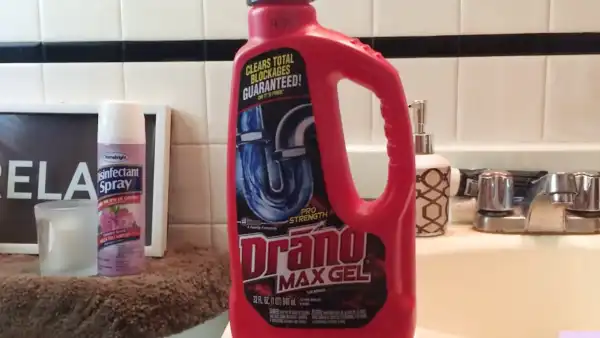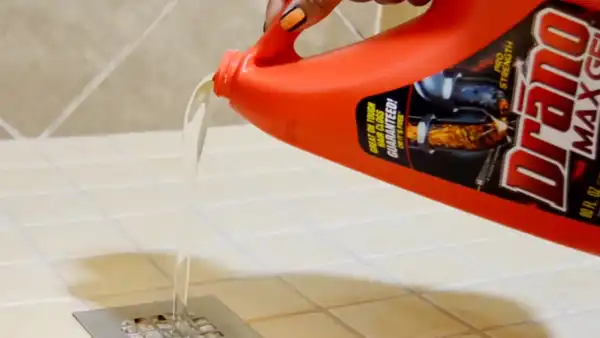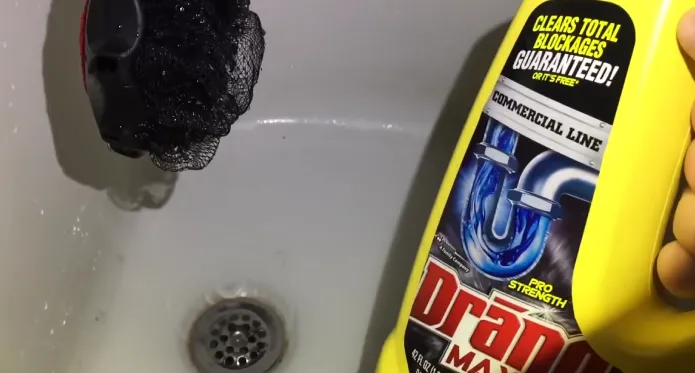Last Updated on October 17, 2023
Clogged bathtub drains are frustrating, but having a reliable solution can help you avoid them. Drano, a well-known brand of drain cleaning products, offers a convenient option for addressing these issues. Now, the fact is, how much Drano should you use in the bathtub for a sparkling space?
It varies depending on the severity of the clogs and which Drano cleaning product you’re using, but a general rule of thumb is to pour 16 ounces. Drano 32 oz may be needed if hair, soap scum, and other debris are blocking the drain.
With this guide, we will walk you through the step-by-step process of cleaning a bathtub with Drano. We are about to transform your bathroom in a way you’ve never seen before.
How Much Drano Should You Use in Bathtub: Details in Steps

Before using Drano cleaning solution in your bathtub, following a series of steps is important to ensure safety and effectiveness.
- Step 01. Read the label
- Step 02. Gather materials
- Step 03. Clear the area
- Step 04. Ventilation
- Step 05. Protective gear
- Step 06. Application
- Step 07. Rinsing and cleaning
- Step 08. Disposal
Let’s take a closer look at each cleaning step.
Step 01. Read the Label
The label contains important information to help you use the Drano cleaning solution correctly and safely.
Look for instructions on how much product to use in your bathtub. Different bathtubs may require different amounts of cleaner, so following the manufacturer’s recommendations is crucial.
The label will also provide safety precautions, such as wearing gloves or protective eyewear while using the product. Also, it may include any specific instructions or recommendations for best results.
Step 02. Gather Materials
Once your protective gear is ready, ensure you have the necessary materials for the cleaning process. You will need the Drano cleaning solution specifically designed for bathtub and shower drains. This solution is formulated to dissolve clogs and clear your drain effectively.
Also, have a scrubbing brush or sponge to clean the bathtub surface after unclogging the drain. Optionally, it may be helpful to have a plunger and a plumbing snake available if the clog is stubborn.
Step 03. Clear the Area
Remove any items from the bathtub area, such as shampoo bottles, soap, or bath toys, to ensure an efficient cleaning. Removing these items eliminates potential obstacles and allows the solution to reach all areas of the bathtub effectively.
Step 04. Ventilation
Proper ventilation is crucial to minimize exposure to any fumes emitted from the Drano cleaning solution. These fumes can be harmful if inhaled in high concentrations, so taking precautions is important.
Opening windows allows fresh air to circulate and dilute any airborne chemicals, preventing them from accumulating and causing respiratory irritation. Alternatively, turning on exhaust fans helps remove the fumes and maintain a safe environment while cleaning your bathtub with Drano.
Step 05. Protective Gear
Wearing protective gloves and safety goggles is essential for your safety while cleaning. Wearing gloves creates a barrier between your skin and the potentially harmful chemicals in the cleaning solution. This reduces the risk of skin irritation or burns when exposed to these substances.
Step 06. Application
To continue with the application process, slowly pour the recommended amount of solution down the drain according to the instructions on the label. For clogged or slow-running drains, pour 16 oz slowly over the drain. If you’re dealing with extremely slow-running drains or complete clogs, pour 32 oz.
Once you’ve poured the solution, allow it to sit for approximately 15 minutes. This designated time period allows the cleaning solution to effectively break down and dissolve any clogs or build-up within your drain.
Step 07. Rinsing and Cleaning
After the designated time period, you can run hot water down the drain to flush out any debris and remaining cleaning solution.
By running a stream of hot water, you create a forceful flow that helps dislodge any stubborn debris clinging to the pipes or drain walls. Also, this action aids in diluting and rinsing away any residual cleaning solution that may have been left behind after application.
Step 08. Disposal
Once you’ve completed the cleaning process, properly seal and store the Drano container in a safe place.
Ensure you follow the instructions on the label to dispose of any remaining cleaning solution or empty containers. By doing so, you ensure that these products are disposed of safely and responsibly.
What happens if you pour too much Drano?

Pouring too much Drano into your bathtub can cause the pipes to corrode. The chemicals in Drano are meant to dissolve clogs and clear the drain, but when used excessively or left for extended periods, they can harm the pipes themselves.
The corrosive nature of Drano can eat away at the inner lining of the pipes, leading to weak spots and eventually causing leaks or even complete pipe failure. Also, pouring excessive amounts of Drano can exacerbate and worsen these issues if there are any cracks or holes in the pipes.
What happens if Drano doesn’t go down?
If Drano doesn’t go down the bathtub drain, it could be due to a few reasons.
One possibility is that the clog is too severe for the Drano solution to dissolve completely. In this case, using a plunger can help create suction and dislodge the clog. Make sure to choose a plunger suitable for your specific type of clog.
Another reason Drano may not go down is if there is an obstruction in the pipes, such as hair or debris that prevents the solution from reaching the clog. In such cases, you may need to manually remove the obstruction before attempting to use Drano again.
Drano in the Bathtub: Understanding Its Uses
When using Drano cleaning solution in a bathtub, following the instructions and using the recommended amount is important. Pouring too much Drano can lead to potential damage to your pipes and fixtures.
If the Drano doesn’t go down properly, it could indicate a more serious clog that may require professional assistance. It’s always best to exercise caution and consult with experts if needed.
There’s no harm in investigating the truth of these theories, which will give you a deeper understanding of how Drano works.

